Simple Queue Service (SQS)
What’s a queue?
Section titled “What’s a queue?”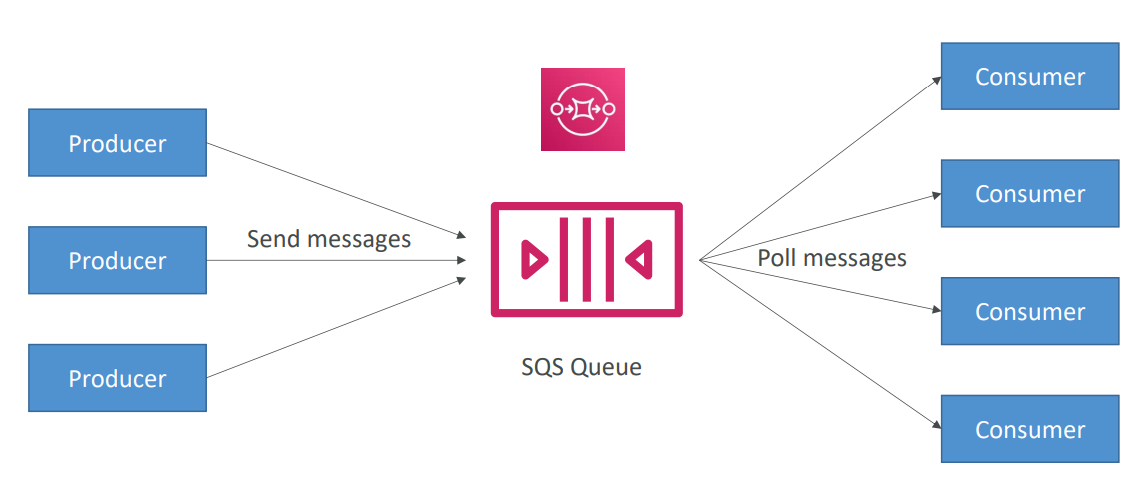
Standard Queue
Section titled “Standard Queue”- Oldest offering (over 10 years old)
- Fully managed
- Scales from 1 message per second to 15,000s per second
- Default retention of messages: 4 days, maximum of 14 days
- No limit to how many messages can be in the queue
- Low latency (<10 ms on publish and receive)
- Horizontal scaling in terms of number of consumers
- Can have duplicate messages (at least once delivery, occasionally)
- Can have out of order messages (best effort ordering)
- Limitation of 256KB per message sent
Producing Messages
Section titled “Producing Messages”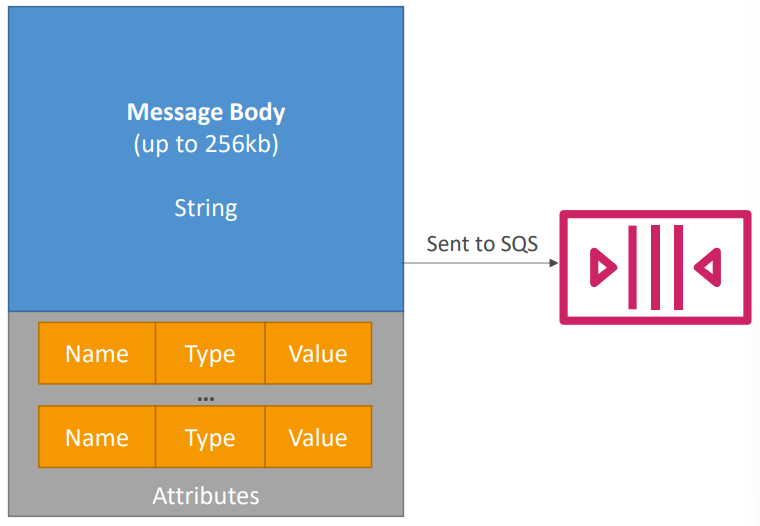
- Define Body
- Add message attributes (metadata – optional)
- Provide Delay Delivery (optional)
- Get back
- Message identifier
- MD5 hash of the body
Consuming Messages
Section titled “Consuming Messages”
- Consumers…
- Poll SQS for messages (receive up to 10 messages at a time)
- Process the message within the visibility timeout
- Delete the message using the message ID & receipt handle
FIFO Queue
Section titled “FIFO Queue”- Newer offering (First In / First out)
- Name of the queue must end in .fifo • Lower throughput (up to 3,000 per second with batching, 300/s without)
- Messages are processed in order by the consumer
- Messages are sent exactly once • 5-minute interval de-duplication usin Duplication ID
Use Cases
Section titled “Use Cases”- Decouple applications (for example to handle payments asynchronously)
- Buffer writes to a database (for example a voting application)
- Handle large loads of messages coming in (for example an email sender)
- SQS can be integrated with Auto Scaling through CloudWatch!
Limits
Section titled “Limits”- Maximum of 120,000 in-flight messages being processed by consumers
- Batch Request has a maximum of 10 messages – max 256KB
- Message content is XML, JSON, Unformatted text
- Standard queues have an unlimited TPS
- FIFO queues support up to 3,000 messages per second (using batching)
- Max message size is 256KB (or use Extended Client)
- Data retention from 1 minute to 14 days
- Pricing:
- Pay per API Request
- Pay per network usage
Security
Section titled “Security”- Encryption in flight using the HTTPS endpoint
- Can enable SSE (Server Side Encryption) using KMS
- Can set the CMK (Customer Master Key) we want to use
- SSE only encrypts the body, not the metadata (message ID, timestamp, attributes)
- IAM policy must allow usage of SQS
- SQS queue access policy
- Finer grained control over IP
- Control over the time the requests come in
Kinesis Data Stream vs SQS
Section titled “Kinesis Data Stream vs SQS”| Kinesis Data Stream | SQS |
|---|---|
| Data can be consumed many times | Queue, decouple applications |
| Data is deleted after the retention period | One application per queue |
| Ordering of records is preserved (at the shard level), even during replays | Records are deleted after consumption (ack / fail) |
| Build multiple applications reading from the same stream independently (Pub/Sub) | Records are deleted after consumption (ack / fail) |
| “Streaming MapReduce” querying capability (Spark, Flink…) | Messages are processed independently for standard queue |
| Checkpointing needed to track progress of consumption (ex: KCL with DynamoDB) | Ordering for FIFO queues (decreased throughtput) |
| Provisioned mode or on-demand mode | Capability to “delay” messages |
| Dynamic scaling of load (no-ops) |
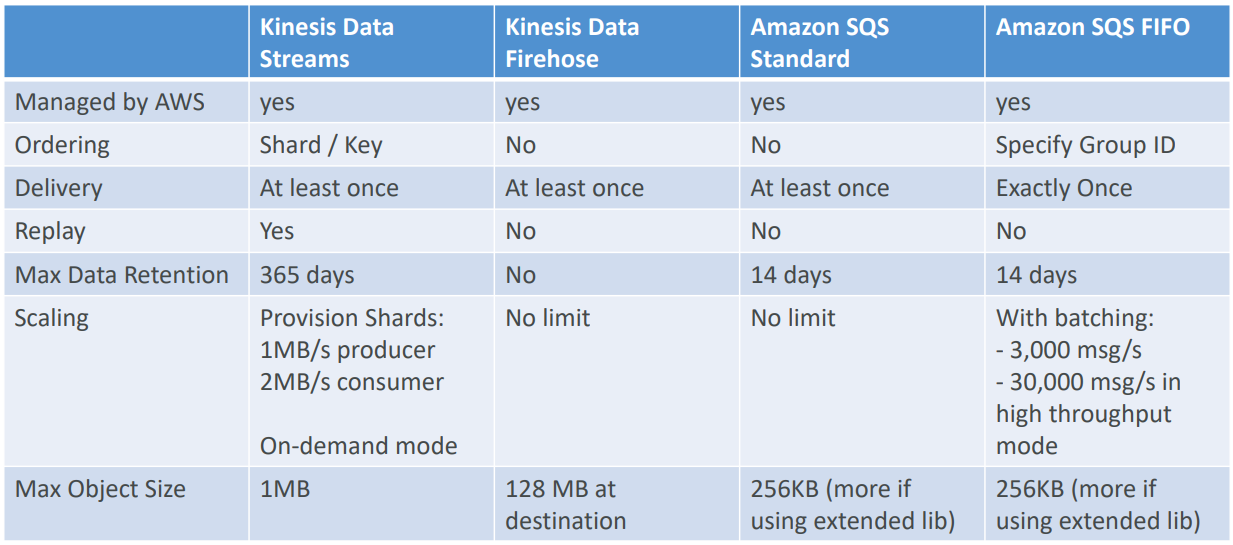
SQS vs Kinesis use cases
Section titled “SQS vs Kinesis use cases”-
SQS use cases
- Order processing
- Image Processing
- Auto scaling queues according to messages.
- Buffer and Batch messages for future processing.
- Request Offloading
-
Kinesis Data Streams use cases
- Fast log and event data collection and processing
- Real Time metrics and reports
- Mobile data capture
- Real Time data analytics
- Gaming data feed
- Complex Stream Processing
- Data Feed from “Internet of Things”
Dead Letter Queue (DLQ)
Section titled “Dead Letter Queue (DLQ)”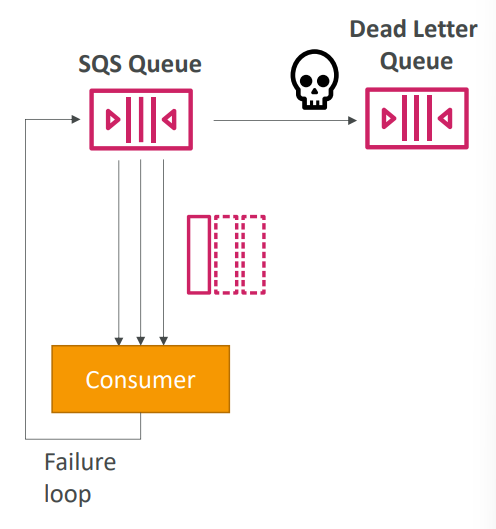
- If a consumer fails to process a message within the Visibility Timeout… the message goes back to the queue!
- We can set a threshold of how many times a message can go back to the queue
- After the MaximumReceives threshold is exceeded, the message goes into a Dead Letter Queue (DLQ)
- Useful for debugging!
- DLQ of a FIFO queue must also be a FIFO queue
- DLQ of a Standard queue must also be a Standard queue
- Make sure to process the messages in the DLQ before they expire
- Good to set a retention of 14 days in the DLQ
SQS DLQ: Redrive to Source
Section titled “SQS DLQ: Redrive to Source”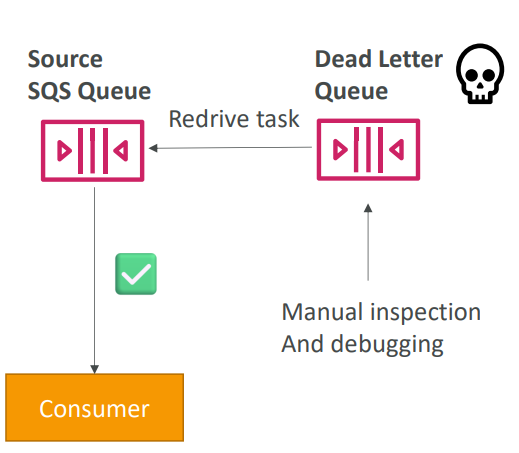
- Feature to help consume messages in the DLQ to understand what is wrong with them
- When our code is fixed, we can redrive the messages from the DLQ back into the source queue (or any other queue) in batches without writing custom code